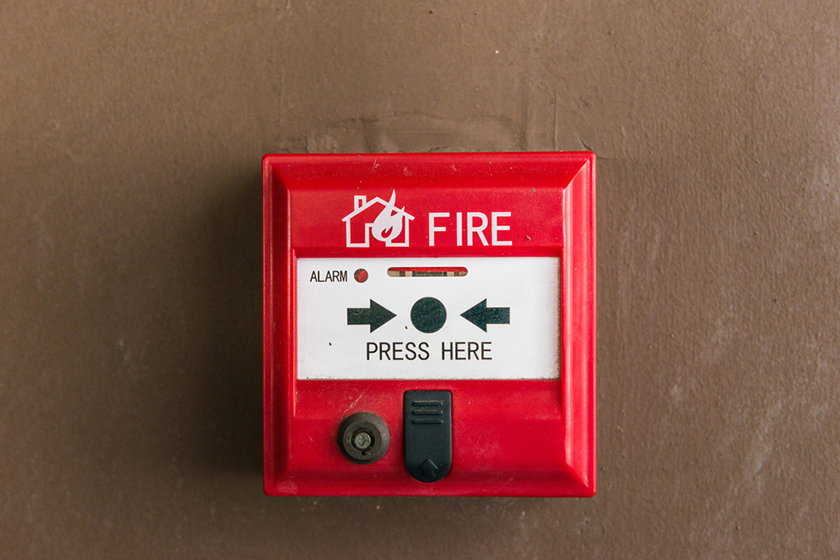How Does A Fire Alarm Work?

Fire alarms are one of the core features of the safety of any building, providing the earliest possible warning in the event of a fire. How does a fire alarm work? Knowing the ins and outs of fire alarms is imperative for both building owners and occupants to make sure their fire alarm systems are functioning optimally.
Fire alarm systems are designed to detect fires quickly, notify people of danger, and alert emergency responders so that appropriate action can be taken. From smoke detectors to control panels, each component plays a big part in the system’s ability to detect and respond to a fire.
The Principles of Fire Alarms
At the center of any fire alarm is its ability to detect dangerous events, like smoke or heat, and trigger a response. The fire alarm system working principle relies on sensors that continuously monitor the environment for changes indicating a fire.
There are different types of fire alarm systems, but they all follow a basic principle: sensing a potential fire, processing that information, and then activating alarms or other safety measures to reduce damage and protect lives.
Most fire alarm systems work through a combination of detection devices, control panels, and notification appliances. The sensors in fire alarms are designed to detect the presence of smoke, heat, or carbon monoxide.
Once detected, the alarm system sends signals to the control panel, which processes the data and activates an appropriate response, such as sounding alarms, sending alerts, or triggering automatic fire suppression systems like sprinklers.
The Part Played by Sensors in Fire Detection
There are several types of sensors used in fire alarm systems, each designed to detect specific fire-related conditions. The most common sensor types are smoke detectors, heat detectors, and carbon monoxide detectors.
These sensors work in slightly different ways, but all serve the main goal of detecting early signs of fire to prevent serious damage.
Smoke detectors are one of the most well-known sensors in fire alarm systems. These detectors can be based on two principles: ionization and photoelectric.
Ionization smoke detectors work by using a small amount of radioactive material to ionize the air inside the sensor, which allows smoke particles to disrupt the current and trigger an alarm. Photoelectric smoke detectors, on the other hand, use a light source to detect smoke. When smoke enters the chamber, it scatters the light, triggering the alarm.
Heat detectors are used to detect a rise in temperature that could indicate the presence of fire. They are usually more suited for environments where smoke detectors may not be reliable, such as kitchens or warehouses.
Heat detectors can be either fixed temperature or rate-of-rise detectors. Fixed temperature detectors activate when the temperature exceeds a certain threshold, while rate-of-rise detectors monitor how quickly the temperature is rising, which can also signal a fire.
Carbon monoxide detectors are popular as an added layer of protection. These detectors sense the presence of carbon monoxide, a colorless, odorless gas produced by combustion.
Elevated carbon monoxide levels can be an early indicator of a fire, especially in its early stages when smoke and heat may not yet be enough to trigger other detectors.
The Process of Fire Alarm Activation
When any of the sensors in a fire alarm system detect smoke, heat, or gas, they send a signal to the fire alarm control panel. This panel acts as the brain of the system, receiving input from all connected detectors and determining whether there is sufficient evidence to warrant triggering an alarm.
If the panel confirms that a fire or dangerous condition exists, it sends a signal to the system’s notification devices. These devices might include audible alarms, visual signals like flashing lights, or even sirens that alert building occupants to evacuate the premises.
Some advanced systems can even activate fire suppression systems, like sprinklers, to help control or extinguish the fire before it spreads.
The fire alarm system may also be linked to emergency management and services, allowing it to send signals directly to local fire departments or security personnel. This connection can help reduce response time and make sure that emergency responders are prepared to act immediately upon arrival.
The Importance of Control Panels in Fire Alarm Systems
The control panel is arguably the most important component of a fire alarm system. It receives data from the detectors, processes that information, and triggers alarms or emergency protocols. Control panels can differ in complexity, depending on the size and needs of the building.
In simpler systems, the control panel might be a single unit that handles the entire building. In larger facilities or multi-building complexes, there may be multiple control panels connected in a network. These panels are typically programmable and can be customized to meet the specific fire protection needs of the building.
Modern fire alarm systems frequently feature touchscreens or digital interfaces that allow system operators to monitor the status of the system in real time. These panels can display the location of alarms and sensor readings, and even provide diagnostic tools to identify faults or areas requiring maintenance.
This advanced technology allows for faster responses and more efficient monitoring of the system, providing maximum protection.
Notification Devices: Making Certain Building Occupants Are Aware
Once the fire alarm system detects a potential fire, notification devices activate to alert building occupants of the danger. These devices play a major role in fire alarm systems because they are responsible for making sure everyone in the building is aware of the emergency.
Audible alarms are the most common notification devices, typically consisting of bells, sirens, or horns. These are designed to be loud enough to be heard throughout the building, even in areas with high ambient noise levels.
Some systems also include visual alarms, like flashing lights or strobes, to alert individuals who may have hearing impairments.
For more advanced systems, voice communication is an option. This feature allows the fire alarm system to broadcast pre-recorded or live messages to guide people during an evacuation, such as “Please exit the building immediately.”
Voice communication can be particularly useful in large buildings where multiple stairwells or exits might be available, so occupants follow the safest evacuation routes.
The Role of Fire Alarm Services in System Maintenance
Maintaining a fire alarm system is necessary for its continued functionality in the event of an emergency. While fire alarms are designed to work autonomously, regular maintenance and testing are essential to confirm that all components are operating correctly.
Fire alarm services often include routine inspections, system testing, and replacing batteries or outdated components. Regular service can prevent false alarms, guarantee compliance with local fire codes, and see to it that the system performs optimally when needed most.
Professional technicians have the training and experience necessary to identify issues before they become critical, providing peace of mind that the system is always prepared.
Many fire alarm services include emergency repairs. If any part of the system fails unexpectedly, it is important to address the issue immediately to avoid the risk of undetected fires. Emergency services can be a lifesaver, especially if the system malfunctions during high-risk periods, such as during construction or when the building is occupied.
Inclusion with Other Building Systems
Modern fire alarm systems are often integrated with other safety and building management systems. For instance, the fire alarm system can be connected to building lighting systems, HVAC systems, and even security networks.
When a fire alarm is triggered, the HVAC system might be automatically shut down to prevent smoke from spreading through the ventilation system, or the lighting system might turn on to guide occupants to exits.
In larger buildings or complexes, this can be extremely beneficial for emergency management, allowing for a faster, more coordinated response. The connection of these systems can boost the overall safety of a building, so fire protection extends beyond just the alarm to include evacuation procedures, air quality control, and even emergency communications.
Choosing Fire Safety Alarms for Complete Protection
At Fire Safety Alarms, we have over 40 years of experience in the industry. We have the expertise necessary to make sure your fire alarm system is always ready to protect against potential fires. From installation to routine maintenance and emergency services, we are committed to delivering the highest standard of safety for your building.
Fire alarm system design and maintenance are critical to the safety of your building and we offer support, 24/7. You can trust us to provide the right solutions for your fire safety needs.
For more information on our services, or if you have any questions about your fire alarm system, reach out to us today. We are here to make certain you and your building are always safe.
